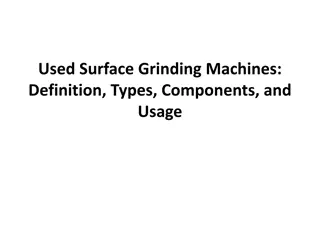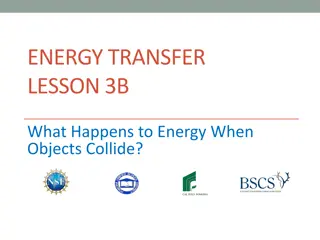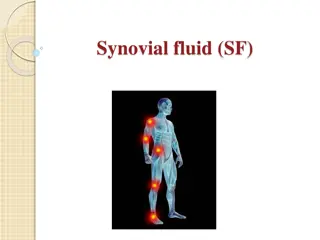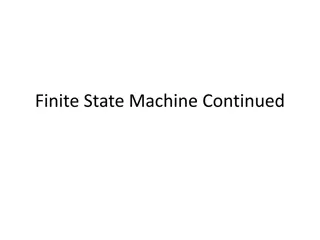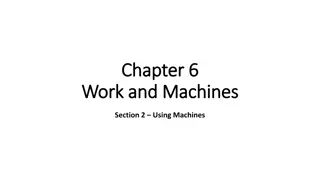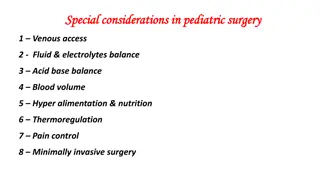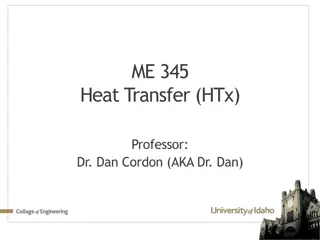Understanding Fluid Machines: Specific Work and Energy Transfer
In Chapter 3 of "Specific Work of Fluid Machines" by Eng. Mesfin B., the focus is on energy transfer and determination of specific work. The chapter covers topics such as energy loss, total pressure, the Bernoulli equation, and more. Learn how to calculate mechanical energy and power transferred by fluid machines. Explore the relationship between specific work, total pressure, and total head in fluid machines. Gain insights on energy conversion and prime movers. Dive into the world of fluid machines and their important characteristics.
Download Presentation

Please find below an Image/Link to download the presentation.
The content on the website is provided AS IS for your information and personal use only. It may not be sold, licensed, or shared on other websites without obtaining consent from the author. Download presentation by click this link. If you encounter any issues during the download, it is possible that the publisher has removed the file from their server.
E N D
Presentation Transcript
CHAPTER 3 Specific Work Of Fluid Machines Eng. Mesfin B. 1
Contents: 3.1 Energy transfer 3.2 Determination of specific work of fluid machines 3.3 Determination of the pressure specific work 3.3 Determination of the adiabatic specific work using thermodynamic diagrams 3.4 Capacity, power and performance characteristics 2
Objective: how to calculate the mechanical energy and power transferred from a fluid machine to a flow medium from measurable quantities. 3
3.1 Energy Transfer 3.1 Energy Transfer Total loss= losses outside + inside Energy loss in the drive Energy loss outside the fluid machine (bearings, couplings) Total energy loss of the fluid machine Energy loss inside the fluid machine (increases in non utilizable-energy content of the flow medium) Total Energy from the source Energy delivered to the fluid machine Useful energy rise of the flow medium (Increase in mechanical energy) Prime Mover/Drive Figure 3.1 Energy transfer from a fluid machine to a flow medium The energy from these sources is converted to mechanical energy using motors, gas or steam turbines or diesel engines The source of energy may be:- electricity, compressed air, steam, or fuel. 4
3.2 Determination Of Specific Work Of Fluid Machines Specific work done, Y. The unit of the specific work is J/kg or m2/s2. W Y = m Head, H. The unit of head is meter [m]. Y H = g 5
Total pressure, Pt. = Pt Y Total pressure, specific work and the total head of a fluid machine are related by the equations:- = = Pt Y gH Note that all the three terms represent the useful energy transferred from the fluid machine to the flow medium in different ways. 6
The Bernoulli Equation The Bernoulli Equation 2 2 2 dp c c 2 dP D S = + + D S c 2 Y g e = + + dY d g dz Y= Specific work of fluid machine P= Static pressure of the flow medium c= mean velocity of the flow medium z= height from datum level = Density of the flow medium g= Gravitational acceleration Pressure Energy Velocity Energy Geodetic Energy Discharge end Suction end Discharge end e e Suction end 7
3.3 Determination of The Pressure Specific Work, 3.3 Determination of The Pressure Specific Work, Y Ypr pr Case1: Pumps and Fans Pumps handle liquids incompressible Hence density variation considered negligible. The pressure difference between the two ends of fans is very small (<15%) . Hence variation in density can be neglected and an average density can be used without much loss in accuracy. D P P = S Y Pr 8
Example 1 A pump is used to move a chemical that has a density of 1200kg/m3 from one tank to another. The mean velocities of the flow medium at the suction and discharge end of the pump are measured to be 1.5 m/s and 2.7m/s respectively. The discharge end of the pump is 20 cm above the suction end. If the static pressure difference between the two ends is 1.8 bar determine the specific work and head of the pump. 9
Example 2 A centrifugal fan is used to exhaust air from a workshop. The ambient temperature of the workshop is 210C. The static pressures at the suction and discharge end of the fan are measured to be 1.01 bar and 1.12 bar respectively. The discharge end is 0.6m above the suction end. Determine the total pressure of the fan if the difference in velocity between the suction and discharge ends is negligible. 10
Case 2: Blowers and Compressors The density of the flow medium changes significantly between the suction and discharge ends therefore we cannot use the equation derived for pumps and fans. D SvdP = YPr 1 = v is the specific volume of the flow medium [v]=m3/kg The equation relating v and P is obtained from thermodynamics. = n Constant P (polytrophic equation) v 11
PD n=1 [Isothermal Compression] dP n = k=Cp/Cv [Adiabatic Compression] P n>k PS v Figure 3.3 Polytrophic curves of compressible flow medium In isothermal compression the temperature of the flow medium is kept constant. In Adiabatic compression there is no heat transfer between the flow medium and the surrounding 12
3.3.1 3.3.1 Y YPr Pr for Isothermal Compression / for Isothermal Compression /Y Yiso iso For isothermal compression (n=1). Hence, = constant = Pv S S P PD, vD n=1 [Isothermal] dP v P P = s s v Yiso P PS, vs dP v P D S D S = = s P s dP v v Y P iso s s P Figure 3.4 Isothermal compression specific work P = D ln v Y P iso s s P S R P T = D S ln Y iso M P S 13
3.3.2 3.3.2 Y Ypr pr for Adiabatic Isentropic Compression ( for Adiabatic Isentropic Compression (Y Yad ad) ) For adiabatic, isentropic compression : n=k=cp/cv. = Constant = K K S P v v P s R 1 C = = = P , R and k C C K S / 1 k v Ps k v k P P V = = S S M v C V / 1 P P / 1 k R k R C v P D S D S = = = = S P s / 1 / 1 k k dP dp C C v Y P P P P ad S s 1 / 1 k k M k M P 1 = 1/k 1/k 1 K 1/k S 1 D 1 S v Y P P P ad s 1 1/k P K D = 1 Y C T ad s P P S 1 K k P K D = 1 v Y P ad S s k 1 P S 1 K RT k P K = D s 1 Y 14 ad k 1 M P S
Table 3.1 Values of the specific heat ratio k Gas k Mono-atomic gases [Helium, Argon, ] 1.66 Diatomic gases [N2, O2, H2, air] 1.44 Methane 1.32 SO2 1.29 Ethane 1.20 15
Example 3 A compressor is used to compress N2 gas. The suction temperature and pressure are 120C and 1.02 bar respectively. The discharge pressure is measured to be 4.3 bar. Determine the useful specific energy transferred from the compressor to the flow medium (a) assuming adiabatic compression (b) isothermal compression. The velocity and geodetic specific energies are negligible as compared to the compression energy. 16
3.3.3 3.3.3 Adiabatic Discharge Temperature Adiabatic Discharge Temperature In designing compression processes it frequently becomes important to estimate the discharge temperature of the flow medium. = K Constant P v / 1 k P v S = = D K D K S v v P P D s v P S D v v v P P P T = = s D S D s D D v T T P T s D D S S k 1 k P = = D T T T ad S D P S Actual adiabatic processes will have greater discharge temperature due to the heat added because of losses inside the machine. 17
Example 4 Determine the minimum compression ratio for which the discharge temperature will be at least 2000C in adiabatic compression of air if the temperature at suction is 150C. Use k=1.44. 18
3.4 Determination of The Adiabatic Specific Work Using Thermodynamic Diagrams The adiabatic isentropic specific work and the adiabatic discharge temperature can also be determined using the thermodynamic diagrams :- temperature-entropy diagram (T-S) and enthalpy entropy (h-S) diagram. For adiabatic compression, the total specific work can be written as:- 2 2 2 c c = + + D s Y Y ge ad 19
From thermodynamics, the energy balance for steady state, steady flow system is given by:- c c h 2 2 2 + + = + D s ge Q Ws Where h is enthalpy of the flow medium, Ws is the shaft work (the useful energy Y, in this case). For adiabatic compression Q=0, 2 2 2 c c + + = D s h ge Y = Yad h = Y h h S ad D 20
Y Yad ad and T and TD, ad D, ad using a T using a T- -S diagram S diagram Constant Pressure Lines PD Actual Compression Adiabatic Isentropic Compression TD TD,ad hD h (Constant enthalpy )lines T TS hS PS S Figure 3.5a Loss free adiabatic compression in T-S diagram 21
Y Yad ad using h using h- -S diagram S diagram Constant pressure lines PD hD Constant temperature lines h[kJ/kg] hS Ts, Ps S[kJ/kg-K] Figure 3.5b Loss free adiabatic compression on h-S diagram 22
3.5 Capacity, Power and Performance Characteristics 3.5 Capacity, Power and Performance Characteristics 3.5.1 3.5.1 Characteristic sizes of a fluid machine Characteristic sizes of a fluid machine The capacity, specific energy (head or total pressure) and brake power are the most important characteristic sizes of a fluid machine. The mass flow rate :- m = Q The useful power :- = N m Y When the specific energy is given in form of total pressure N = QP t 23
It is good to note that the useful power in compressors and blower is calculated in two different ways. For isothermal compression:- = + + Y Y Y Y ios vel geo For adiabatic:- = + + Y Y Y Y ad vel geo In most cases the velocity and geodetic energies are too small as compared to the compression energy and the two are neglected. Hence Y = Y = Y Y ios ad 24
The brake power =the useful power + the total power loss (internal and external power losses) the brake power =the total power input to the fluid machine (output of the drive) + the useful power is the output power of the fluid machine. Hence the overall efficiency =the useful power (output) / the brake power (input). 25
N = N b Where:- = Overall efficiency Nb= brake power N=useful power Since the useful power in case of compressors can be calculated as either isothermal or adiabatic the efficiency is also defined likewise. QY QgH = = N N b b QY QY = iso = ad iso N ad N b b 26
Example 5 The test result of an air compressor is presented below. Suction End Absolute Pressure 1.0 bar Suction Temperature 180C Flow rate at suction condition 500m3/hr Discharge End Absolute Pressure 2.5 bar The brake power (output power of the motor) is 20.4 kW. Determine the adiabatic and isothermal efficiency of the compressor. Neglect the velocity and geodetic energies. 27
Example 6:- Determine the power saving in compressing 1 kg/s of CO2 from 1atm and 150C to (a) 4atm (b) 20atm according to isothermal rather than adiabatic compression. What will be the adiabatic discharge temperatures? 28
3.5.2Performance Characteristics of Fluid Machines The capacity, head (or total pressure), brake power and efficiency of a given fluid machine are interrelated. It is an important document for the proper operation, maintenance and evaluation of the fluid machine. for pumps H=f (Q), Nb=f(Q) and Efficiency=f(Q) 30 0.8 15 =f(Q) H=f(Q) for fans and compressors Pt=f(Q) 0.6 20 10 N [kW] Eff. H [m] 0.4 N=f(Q) 10 5 0.2 Figure 3.6 Performance characteristic curve of centrifugal pump. The H-Q, Nb-Q and -Q curves are known as :- head-capacity curve, power curve and efficiency curve respectively. 29
3.5.3 The Operating Point The operating point can then be found by drawing the system H-Q curve and the pump H-Q curve on the same scale as shown in Figure 3.8. The efficiency and brake power can then be determined from the -Q, and Nb-Q relations of the pump. Pump characteristics H[m] Operating point System characteristics Q[m3/hr] Figure 3.8 The operating point 30
The system characteristic in pumping is commonly given as head capacity curve. For systems using fans, blowers and compressors it is given as pressure-capacity curve. H[m] Pt[kPa] Q[m3/hr] Q[m3/hr] Figure 3.7 Typical system characteristics 31
Example 7 A centrifugal pump running at a speed of 1450 rpm is used to move a chemical that has a density of 920 kg/m3. The head capacity curve and efficiency curve of the pump and the characteristic curve of the system are given in Figure 3.9. (a)Determine the volume flow rate, head and coupling power at the working point? (b)What will be the saving in pumping 1,000,000m3 if the pump runs at the best efficiency point as compared to the working point as indicated in Figure 3.9? Assume motor = 0.97, cost of electricity 0.75 Birr/ kW-hr 32
0.90 16 0.80 0.70 12 0.60 Efficiency 0.50 Head[m] 8 0.40 0.30 4 0.20 0.10 0 0.00 0 50 100 150 200 Q[m3/hr] Figure 3.9 Pump and system characteristic curves 33


